Thrips, small insects classified under the Thysanoptera order, pose a menacing threat to your vibrant indoor foliage. With an estimated 6000 species globally, these minute pests, often just millimeters long, exhibit a voracious appetite for plant sap. Although their size may seem insignificant, thrips can inflict substantial harm on your precious houseplants. Research conducted by the University of California Statewide Integrated Pest Management Program reveals that they puncture plant cells to extract their contents, leading to discoloration, deformity, and in severe cases, plant death.
Identifying these intruders is a challenge due to their minuscule size, quick movement, and propensity to hide on the undersides of leaves. However, their presence can often be confirmed through telltale signs like silver-white streaks, black spots of excrement, or the noticeable decline in your plant’s health.
In this comprehensive guide, we’re addressing these hurdles by equipping you with knowledge about the biology of thrips, methods to identify, eradicate, and prevent their infestations, ensuring your indoor greenery remains lush and healthy.
What Are Thrips?
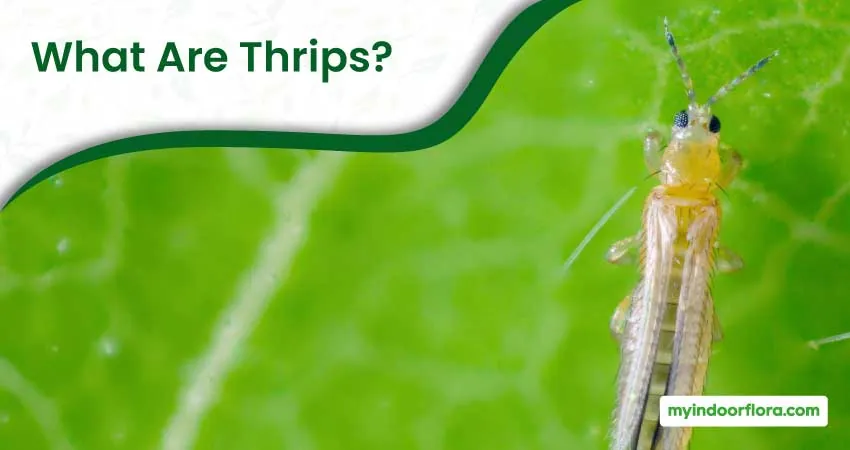
Thrips are minuscule insects known for their slender bodies and fringed wings, classified under the Thysanoptera order. Their name, derived from the Greek word ‘thysanos’ meaning tassel, and ‘pteron’ meaning wing, perfectly describes their unique wing structure.
According to a comprehensive taxonomic analysis by Adriano Cavalleri et al. in the Zootaxa journal, there are approximately 6000 identified species of thrips globally, all exhibiting a voracious appetite for plant sap.
What Do Thrips Look Like?
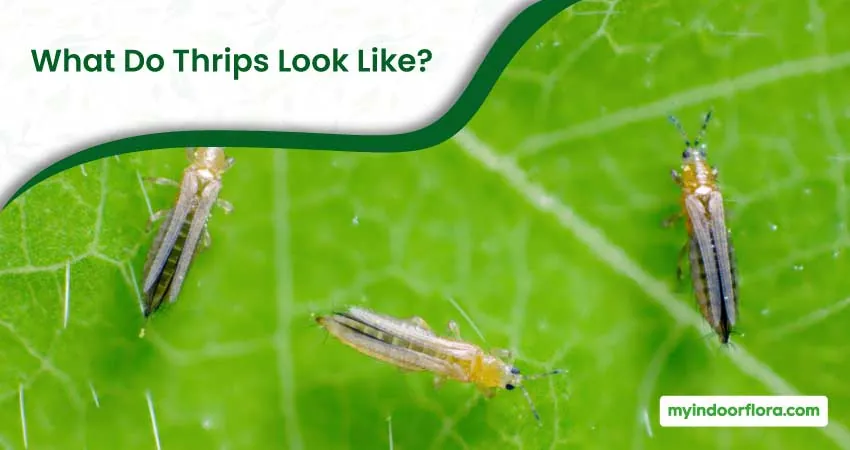
Thrips are tiny, typically less than 1 mm in length, with most species being cylindrical and slender. They exhibit variation in color ranging from translucent white or pale yellow to dark brown or black, depending on their species and life stage. Notable for their characteristic fringed wings, adult thrips often appear to have feathery extensions on their bodies. However, not all thrips are winged; some species or life stages may be wingless.
Thrips Life Cycle
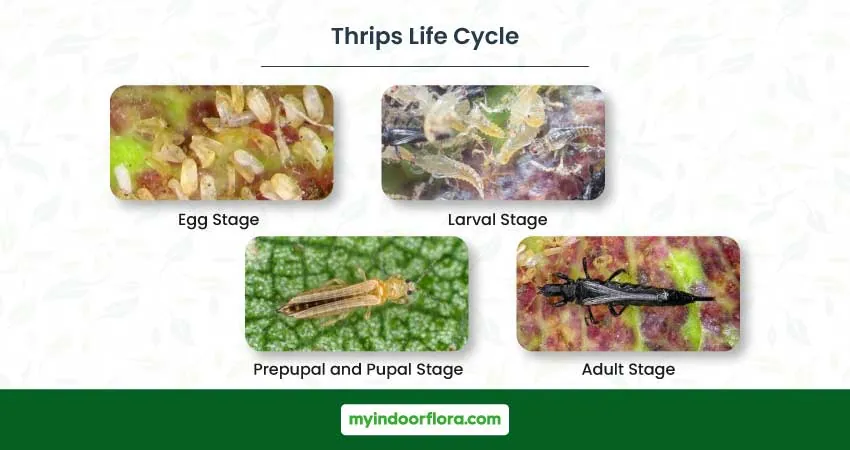
Understanding the life cycle of thrips can offer crucial insights into their habits and vulnerabilities, thereby helping in the formulation of effective control strategies. Here’s a detailed overview of their life cycle:
- Egg Stage: Female thrips lay their eggs inside plant tissues, a feature made possible by their saw-like ovipositor. This characteristic provides the eggs with protection, making them difficult to target with control measures. The eggs hatch within a few days to a couple of weeks, depending on the species and environmental conditions.
- Larval Stage: Once hatched, the larvae emerge and start feeding on plant tissues. This is the stage where they cause the most damage as they feed voraciously on leaves, flowers, or fruits, depending on the species. There are two larval instars, both of which are wingless and typically stay on the plant to feed.
- Prepupal and Pupal Stage: After the second larval instar, thrips enter a non-feeding prepupal stage, followed by the pupal stage. During these stages, they often drop to the soil or leaf litter, where they are less exposed to control measures applied to the plant.
- Adult Stage: The adults then emerge, equipped with wings (in most species), and can move to other plants. Females of many species can reproduce without mating, meaning a single individual can start an infestation.
| Stage | Duration | Impact on Houseplants | Control Strategy |
|---|---|---|---|
| Egg | Few days to weeks | None directly, but lays the groundwork for future damage | Hard to control due to protection inside plant tissue |
| Larval | 1-3 weeks | Most damage due to feeding on plant tissues | Target with insecticides, soaps, or biological control (predatory insects) |
| Prepupal & Pupal | 1-2 weeks | Minimal direct damage as they are non-feeding, potential for future infestations | Difficult to control as they are often hidden in the soil or leaf litter |
| Adult | 3-4 weeks (can vary) | Can spread to other plants and lay eggs for the next generation | Control with insecticides, soaps, traps, or biological control |
By understanding their life cycle, you can anticipate their next move and strategically implement control measures. For instance, knowing that the prepupal and pupal stages often occur in the soil or leaf litter, you can target these areas with appropriate treatments. Also, knowing that the larval stages cause the most damage can inform you to act quickly at the first sign of an infestation. Finally, recognizing that adults can fly and spread to other plants can prompt you to isolate infested plants and protect uninfested ones.
Where Do Thrips Come From?
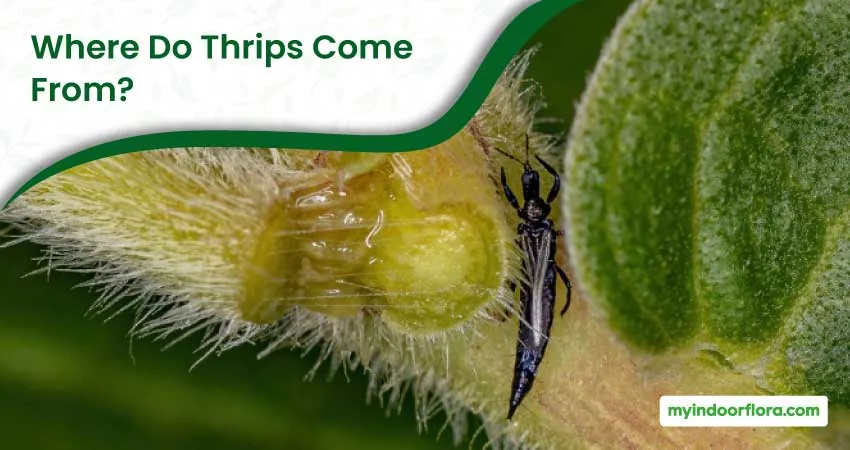
Thrips can originate from various sources. One of the most common routes is hitching a ride on new plants introduced to your indoor garden. They can also travel indoors from an outdoor garden, carried by wind or on clothing. Thrips can even emerge from potting soil, as some species drop to the ground to pupate. Moreover, certain species of thrips are known to be attracted to specific colors, especially blue, yellow, and white, potentially luring them towards your houseplants.
What Houseplants Do Thrips Eat?

Thrips are not very picky eaters and are known to feed on a wide range of houseplants. A study by Reitz SR in the Journal of Integrated Pest Management states that certain thrips species like Western Flower Thrips have a broad host range, which includes over 250 plant species.
Among houseplants, they are commonly found on African violets, dieffenbachia, hoya, and various species of ivy. However, they also display a particular preference for succulent new growth on plants such as roses, gladioli, and pelargoniums.
Thrips Damage On Houseplants
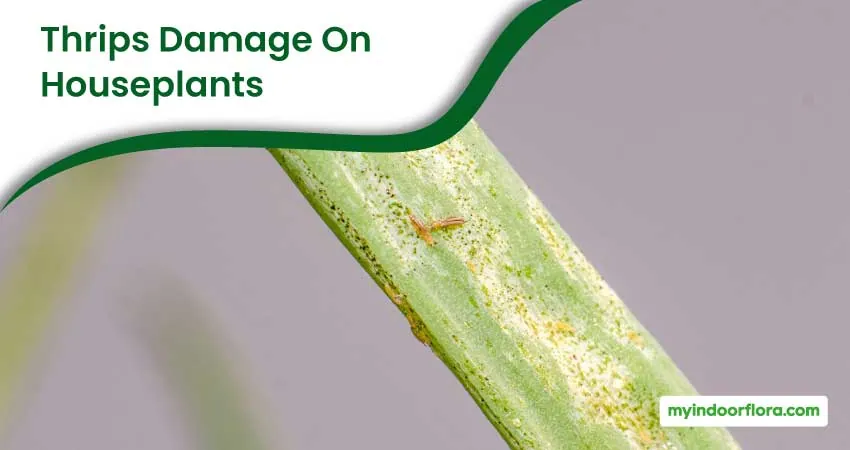
The feeding activity of thrips results in characteristic damage that, when recognized early, can help in effective management. They use their mouthparts to puncture plant cells and suck out the contents, resulting in silvery streaks or spots. Over time, these discolored areas may turn brown, and leaves may become distorted or drop off the plant.
In addition to direct feeding damage, certain thrips species can vector plant viruses. According to the American Phytopathological Society, the most notorious of these is the Tomato Spotted Wilt Virus (TSWV), vectored by Western Flower Thrips, which can infect a wide range of ornamental plants. Thus, the impact of thrips on houseplants can range from cosmetic damage to potentially fatal disease transmission.
How Can You Confirm Thrips Infestation on Your Houseplants?
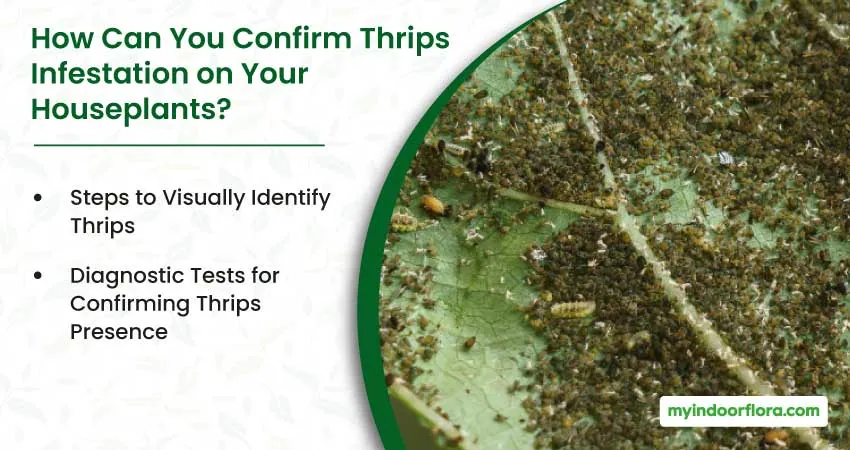
Now that you’re equipped with knowledge about thrips, how can you be sure that the culprits wreaking havoc on your plants are indeed thrips?
Steps to Visually Identify Thrips
Look closely at your plant’s leaves, particularly the undersides. Adult thrips are small, fast-moving insects, while the larvae are pale and harder to spot. You might also notice black specks, which are their droppings.
Diagnostic Tests for Confirming Thrips Presence
Place a sheet of white paper beneath the plant and gently shake the leaves. Thrips will fall onto the paper, confirming their presence. Alternatively, use yellow or blue sticky traps near the affected plant and check after a few days for thrips.
How To Get Rid of Thrips from Your Houseplants?
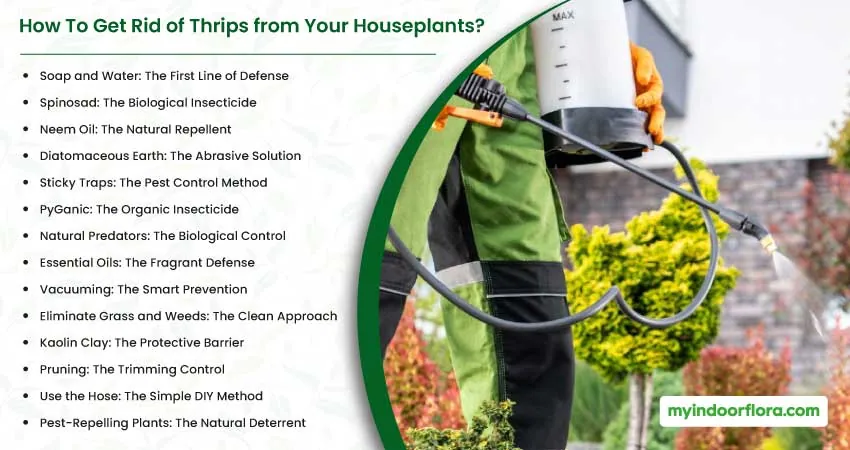
Don’t despair at the sight of thrips; there are several methods to evict these unwelcome guests from your indoor garden.
1. Soap and Water: The First Line of Defense
A simple yet effective home remedy to combat thrips is a solution of soap and water. Mix 5 tablespoons of liquid dish soap in a gallon of water, shake well, and spray it all over your indoor or greenhouse plants. This solution can also be poured around the base of plants to kill off the developing nymphs (larvae).
2. Spinosad: The Biological Insecticide
Spinosad, a biological insecticide derived from a naturally occurring soil bacterium, is another great weapon against thrips. It’s usually combined with other compounds and sold in a dilutable liquid form. It’s particularly effective against thrip bugs and other soft-bodied garden pests.
3. Neem Oil: The Natural Repellent
Neem oil is a natural pesticide and repellent effective against thrips. To use neem oil against thrips, combine 2 teaspoons of liquid soap with 4 teaspoons of neem oil and a gallon of water. Shake well and spray this DIY thrips spray directly on the pests to kill them.
4. Diatomaceous Earth: The Abrasive Solution
Diatomaceous earth, a natural substance that is sharp and abrasive to the exoskeleton of many insects, has a dehydrating effect, making it perfect for getting rid of thrips naturally. Sprinkle it around plants and spread it on the soil in your garden or pots. However, remember to reapply it after rain or watering the garden.
5. Sticky Traps: The Pest Control Method
Sticky traps are another common pest control method that can be used for controlling thrips organically. Different colors attract different types of insect pests (blue and yellow for thrip insects). Hang these near any infected plants, inside or outside the house. The critters will become stuck to the traps and die not long after.
6. PyGanic: The Organic Insecticide
PyGanic is an excellent organic insecticide for thrips and other insect pests. It contains pyrethrins, compounds derived from some chrysanthemum flowers. Pyrethrin is usually combined with other ingredients and is available in commercial sprays.
7. Natural Predators: The Biological Control
One of the successes of organic gardening is being able to attract natural enemies. These include lacewings and predatory mites, but the star of these predators is the ladybug. Although small and pretty, the lady beetle is a killer of many garden pests. The thrips predator (Amblyseius cucumeris) also eats thrip eggs and larvae.
8. Essential Oils: The Fragrant Defense
A few drops of essential oils diluted with water make a powerful spray against all types of bad bugs and insects. Essential oils such as orange oil, marjoram, and mint oil seemed successful. Astandard recipe is to combine 1 to 2 ounces of essential oil with a gallon of water. Spraying the plants thoroughly helps treat thrips.
9. Vacuuming: The Smart Prevention
Making use of your vacuum is a smart way to prevent thrips from taking over. The critters are so lightweight that gusts of wind transport them from plant to plant. Therefore, it is relatively easy to remove them with a vacuum cleaner that will suction them into a disposable dust bag. Running a small hand-held vacuum gently along and under the stems and leaves of plants will draw up large numbers of pests.
10. Eliminate Grass and Weeds: The Clean Approach
Keeping a garden clean is one way of reducing infestations of unwanted insects. As a result, regular cutting and weeding and clearing up dead leaves or debris will help keep the numbers down.
11. Kaolin Clay: The Protective Barrier
Kaolin clay, a natural mineral, creates a protective barrier when applied to leaves and fruits, which thrips cluster around. However, it must be mixed with water and applied with a sprayer. Kaolin clay helps deter thrips from feeding. This organic thrips treatment works great for houseplants as well as those on the outside.
12. Pruning: The Trimming Control
Regular pruning to cut off infested plant parts is another home remedy for thrips control. Pest thrips can cause damage to leaves, stems, flowers, and fruits, so an infestation might require heavy pruning.
13. Use the Hose: The Simple DIY Method
A simple DIY method for getting rid of thrips is to use the hose. Not all species of these tiny insects are good flyers. They also find it difficult to move around in moist air. As a result, using the hose to mist plants can restrict their movement.
14. Pest-Repelling Plants: The Natural Deterrent
Plants that repel thrips include basil, marigolds, and garlic. If possible, plant these in your garden to help keep the critters away.
How to Prevent Future Thrips Infestations on Your Indoor Plants?
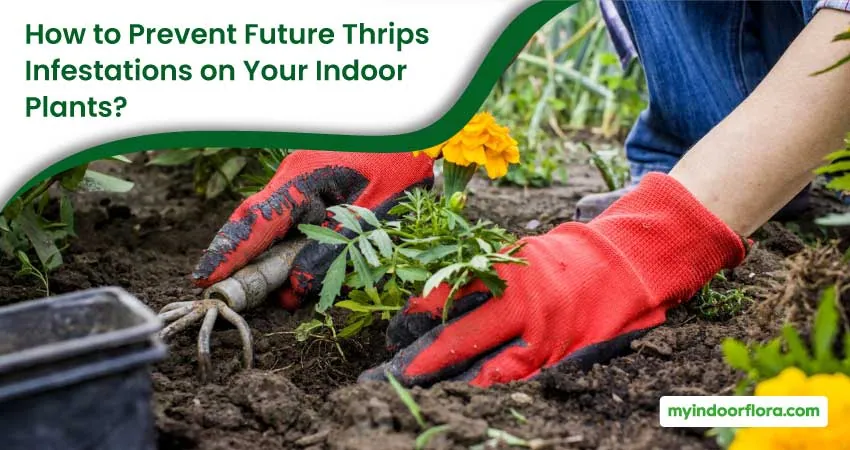
Preventing thrips infestations is a crucial aspect of houseplant care. Here are some proactive strategies you can implement to keep these pesky insects at bay:
- Quarantine New Plants: Thrips can hitch a ride into your home on newly purchased plants. Always quarantine new additions for a couple of weeks and observe them closely for signs of pests.
- Regular Inspections: Regularly inspect your plants, especially the undersides of leaves and buds, where thrips often reside. Early detection can help prevent an infestation from spreading.
- Proper Hygiene: Keep your plant area clean. Remove fallen leaves and flowers that could serve as breeding sites for thrips.
- Balanced Fertilization: Over-fertilization, particularly with nitrogen-rich fertilizers, can encourage thrips populations by promoting succulent growth. Stick to a balanced fertilization regimen suitable for your specific plants.
- Use Reflective Mulches: In larger indoor gardens or greenhouses, reflective mulches can be used to deter thrips. According to a study published in the Crop Protection journal, silver-colored mulches can reduce thrips populations by up to 78%.
- Beneficial Insects: Encourage or introduce beneficial insects that prey on thrips, such as lacewings, ladybugs, or predatory mites.
- Plant Resistance: Choose plant varieties that are resistant to thrips or the viruses they transmit. Some plant cultivars have been bred for resistance and can be a valuable part of an integrated pest management strategy.
The following table highlights some of these strategies and their effectiveness:
| Prevention Strategy | Level of Effectiveness | Additional Information |
|---|---|---|
| Quarantine New Plants | High | Can prevent introduction of new pests |
| Regular Inspections | High | Early detection can prevent spread |
| Proper Hygiene | Medium | Limits potential breeding sites |
| Balanced Fertilization | Medium | Over-fertilization can encourage thrips |
| Reflective Mulches | High in large indoor gardens | Silver-colored mulches can significantly reduce thrips |
| Beneficial Insects | Varies | Depends on species and environmental conditions |
| Plant Resistance | Varies | Some cultivars may be resistant to thrips or their viruses |
With careful monitoring and proactive management strategies, you can effectively limit the risk of future thrips infestations on your houseplants.
Frequently Asked Questions
Can Thrips Infestation be Fatal to Houseplants?
Are Certain Houseplants More Prone to Thrips Infestation?
Can Thrips Spread to Other Houseplants?
What Should be Done if Thrips Keep Returning?
Are Thrips Harmful to Humans or Pets?
Conclusion
Understanding the enemy, in this case, thrips, is half the battle. The rest lies in prompt and appropriate action. Early detection, effective control measures, and preventive strategies will ensure that your indoor garden stays lush, vibrant, and free from thrips.
